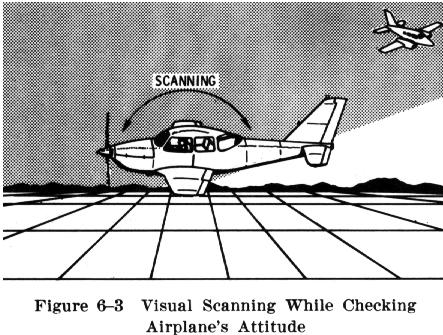Straight and level Flight
Straight and level Flight
Straight and level flight is just what the name implies
- flight in which a constant heading and altitude are maintained. It is
accomplished by making immediate corrections for deviations in direction
and altitude from unintentional slight turns, descents, and climbs.
The pitch attitude for level flight (constant altitude)
is usually obtained by selecting some portion of the airplane's nose as
a reference point, and then keeping that point in a fixed position relative
to the horizon. That position should be cross checked occasionally against
the altimeter to determine whether or not the pitch attitude is correct.
If altitude is being gained or lost, the pitch attitude should be readjusted
in relation to the horizon and then the altimeter rechecked to determine
if altitude is now being maintained. The application of forward or back
elevator pressure is used to control this attitude.
| The pitch information obtained from the attitude indicator
also will show the position of the nose relative to the horizon and will
indicate whether elevator pressure is necessary to change the pitch attitude
to return to level flight (Fig. 6-2).
In all normal maneuvers the term "increase the pitch attitude"
implies raising the nose in relation to the horizon; the term "decreasing
the pitch" means lowering the nose.
To achieve straight flight (constant heading), the pilot
selects two or more outside visual reference points directly ahead of the
airplane (such as fields, towns, lakes, or distant clouds, to form points
along an imaginary line) and keeps the airplane's nose headed along that
line. Roads and section lines on the ground also offer excellent references
- straight flight can be maintained by flying parallel or perpendicular
to them. While using these references, an occasional check of the heading
indicator should be made to determine that the airplane is actually maintaining
flight in a constant direction. |
|
Straight flight (laterally level flight) may also be accomplished
by visually checking the relationship of the airplane's wingtips with the
horizon. Both wingtips should be equidistant above or below the horizon
(depending on whether the airplane is a high wing or low wing type), and
any necessary adjustments should be made with the ailerons, noting the
relationship of control pressure and the airplane's attitude.
 |
Continually observing the wingtips has advantages other than being
a positive check for leveling the wings. It also helps divert the pilot's
attention from the airplane's nose, prevents a fixed stare, and automatically
expands the radius of visual scanning (Fig. 6-3). In straight and level
flight the wingtips can be used for both estimating the airplane's laterally
level attitude or bank, and to a lesser degree, its pitch attitude.
Any time the wings are banked, even though very slightly,
the airplane will turn. Thus, close attention should be given to the attitude
indicator to detect small indications of bank, and to the heading indicator
to note any change of direction.
When the wings are approximately level, straight flight could be maintained
by simply exerting the necessary forces on the rudder in the desired direction.
However, the practice of using rudder |
alone is not correct and may make precise control of the airplane difficult.
Straight and level flight requires almost no application of control pressure
if the airplane is properly trimmed and the air is smooth. For that reason,
the pilot must not form the habit of constantly moving the controls unnecessarily.
When practicing this fundamental flight maneuver, the pilot
should trim the airplane so it will fly straight and level without assistance.
This is called "hands off flight." The trim controls, when correctly used,
are aids to smooth and precise flying. Improper trim technique usually
results in flying that is physically tiring, particularly in prolonged
straight and level flight. By using the trim tabs to relieve all control
pressures, the pilot will find that it is much easier to hold a given altitude
and heading. The airplane should be trimmed by first applying control pressure
to establish the desired attitude, and then adjusting the trim so that
the airplane will maintain that attitude without control pressure in "hands
off flight."
For all practical purposes, the airspeed will remain constant
in straight and level flight with a constant power setting. Practice of
intentional airspeed changes by increasing or decreasing the power, will
provide an excellent means of developing proficiency in maintaining straight
and level flight at various speeds. Significant changes in airspeed will,
of course, require considerable changes in pitch attitude and pitch trim
to maintain altitude. Pronounced changes in pitch attitude and trim will
also be necessary as the flaps and landing gear are operated.

